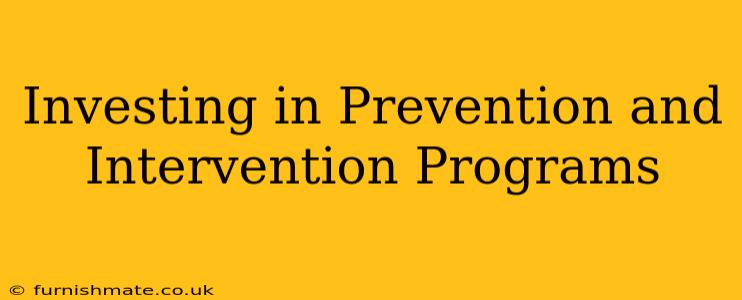Investing in prevention and intervention programs might seem like a cost upfront, but the long-term benefits far outweigh the initial expenditure. These programs address societal issues at their root, preventing escalation and reducing the need for more expensive reactive measures later. This proactive approach not only saves money but also improves overall community well-being. This article delves into the multifaceted advantages of such investments, exploring different program types and addressing common questions surrounding their effectiveness.
Why Invest in Prevention and Intervention?
Prevention and intervention programs target a wide range of societal challenges, from crime and substance abuse to health issues and educational setbacks. By addressing these problems early, we can significantly reduce their impact on individuals, families, and communities. The core principle is simple: preventing a problem is always cheaper and more effective than dealing with its consequences. Consider the cost of treating a chronic illness versus funding preventative healthcare measures, or the economic burden of incarceration compared to investing in early childhood education and crime prevention initiatives.
What Types of Prevention and Intervention Programs Exist?
Prevention and intervention programs come in many forms, tailored to specific needs and demographics. Some examples include:
- Early Childhood Education: Providing high-quality preschool programs can improve cognitive development, social skills, and reduce future involvement in the criminal justice system.
- Substance Abuse Prevention: Programs aimed at educating youth about the dangers of drug and alcohol use can reduce addiction rates and associated healthcare costs.
- Mental Health Services: Early intervention for mental health issues can prevent escalation into more serious problems, reducing the need for long-term care.
- Crime Prevention Programs: Community policing, youth mentoring, and after-school programs can reduce crime rates and improve public safety.
- Public Health Initiatives: Initiatives promoting healthy lifestyles, disease prevention, and vaccination campaigns significantly reduce healthcare burdens.
How Effective Are Prevention and Intervention Programs?
The effectiveness of prevention and intervention programs varies depending on several factors, including the program's design, implementation, and the community it serves. However, numerous studies demonstrate the positive impact of well-designed programs. Successful programs often incorporate evidence-based strategies, engage communities actively, and provide ongoing support.
Are Prevention Programs Cost-Effective?
Yes, numerous studies show that prevention programs are cost-effective in the long run. While they require initial investment, they save money by reducing the need for more expensive interventions later. The return on investment can be substantial, with savings realized across various sectors like healthcare, criminal justice, and social services.
What Are the Challenges in Implementing Prevention and Intervention Programs?
Implementing effective prevention and intervention programs presents challenges. These include securing sufficient funding, building community support, overcoming logistical hurdles, and ensuring program fidelity (that the program is implemented as designed). Effective evaluation and data collection are crucial for demonstrating impact and securing continued funding.
How Can We Measure the Success of Prevention and Intervention Programs?
Measuring the success of prevention and intervention programs requires a multifaceted approach. Key metrics include reduced rates of the targeted problem (e.g., crime, substance abuse), improved health outcomes, increased educational attainment, and enhanced community well-being. Rigorous evaluation methods, including both quantitative and qualitative data collection, are essential for assessing program effectiveness.
Where Can I Find Funding for Prevention and Intervention Programs?
Funding for prevention and intervention programs can come from various sources, including government grants, private foundations, corporate sponsorships, and community fundraising initiatives. Researching available funding opportunities and developing strong grant proposals are crucial for securing financial support.
Conclusion: Investing in a Brighter Future
Investing in prevention and intervention programs is not merely a financial decision; it's an investment in a healthier, safer, and more prosperous future. By proactively addressing societal challenges, we can create lasting positive change, improve lives, and ultimately save money in the long run. The evidence is clear: a proactive approach to prevention and intervention is a smart investment that yields significant returns for communities and society as a whole.

